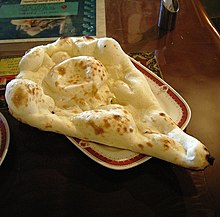Naan bread
 |
|
| Place of origin | South Asia, Central Asia, Southeast Asia |
|---|---|
| Region or state | India, Pakistan, Bangladesh, Afghanistan, Iran, Malaysia, Indonesia and Singapore |
| Serving temperature | Hot, room temperature |
| Main ingredients | Wheat flour (e.g. atta, maida), water, cooking fat (e.g. butter, ghee), yogurt, milk (optional) |
| |
|
| Nutritional value per 100 g (3.5 oz) | |
|---|---|
|
50.43
|
|
| Sugars | 3.55 |
| Dietary fiber | 2.2 |
|
5.65
|
|
|
9.62
|
|
| Vitamins | |
| Thiamine (B1) |
(68%)
0.78 mg |
| Riboflavin (B2) |
(43%)
0.51 mg |
| Pantothenic acid (B5) |
(0%)
0 mg |
| Vitamin B6 |
(7%)
0.095 mg |
| Folate (B9) |
(0%)
0 μg |
| Vitamin E |
(5%)
0.79 mg |
| Vitamin K |
(0%)
0 μg |
| Minerals | |
| Calcium |
(8%)
84 mg |
| Iron |
(25%)
3.25 mg |
| Magnesium |
(8%)
27 mg |
| Manganese |
(0%)
0 mg |
| Phosphorus |
(14%)
100 mg |
| Potassium |
(3%)
125 mg |
| Sodium |
(31%)
465 mg |
| Zinc |
(9%)
0.81 mg |
|
|
|
|
|
| Percentages are roughly approximated using US recommendations for adults. Source: USDA Nutrient Database |
|
|
|
Naan is a leavened, oven-baked flatbread found in the cuisines of West Asian, Central Asia and South Asia.
The earliest appearance of "naan" in English is from 1810, in a travelogue of William Tooke. The Persian word nān 'bread' is attested in Middle Persian as n'n 'bread, food', which is of Iranian origin, and is a cognate with Parthian ngn, Balochi nagan, Sogdian nγn-, and Pashto nəγan 'bread'.
The form naan has a widespread distribution, having been borrowed in a range of languages spoken in Central Asia and South Asia, where it usually refers to a kind of flatbread. The spelling naan is first attested in 1979, and has since become the normal English spelling.
Other than etymology, "naan", as we know it today, originates from Central and South India with influence from the Middle-East. The most familiar and readily available varieties of naan in Western countries are the South Asian varieties. In Iran, from which the word ultimately originated,nān (نان) does not carry any special significance, as it is merely the generic word for any kind of bread, as well as in other West Asian nations or ethnic groups in the region, such as amongst Kurds, Turks, Azerbaijanis (from both Azerbaijan and Iran), etc. Naan in parts of South Asia usually refers to a specific kind of thick flatbread (another well-known kind of flatbread is chapati). Generally, it resembles pita and, like pita bread, is usually leavened with yeast or with bread starter (leavened naan dough left over from a previous batch); unleavened dough (similar to that used for roti) is also used. Naan is cooked in a tandoor, from which tandoori cooking takes its name. This distinguishes it from roti, which is usually cooked on a flat or slightly concave iron griddle called a tava. Modern recipes sometimes substitute baking powder for the yeast. Milk or yogurt may also be used to impart distinct tastes to the naan. Milk used instead of water will, as it does for ordinary bread, yield a softer dough. Also, when bread starter (which contains both yeast and lactobacilli) is used, the milk may undergo modest lactic fermentation.
...
Wikipedia
